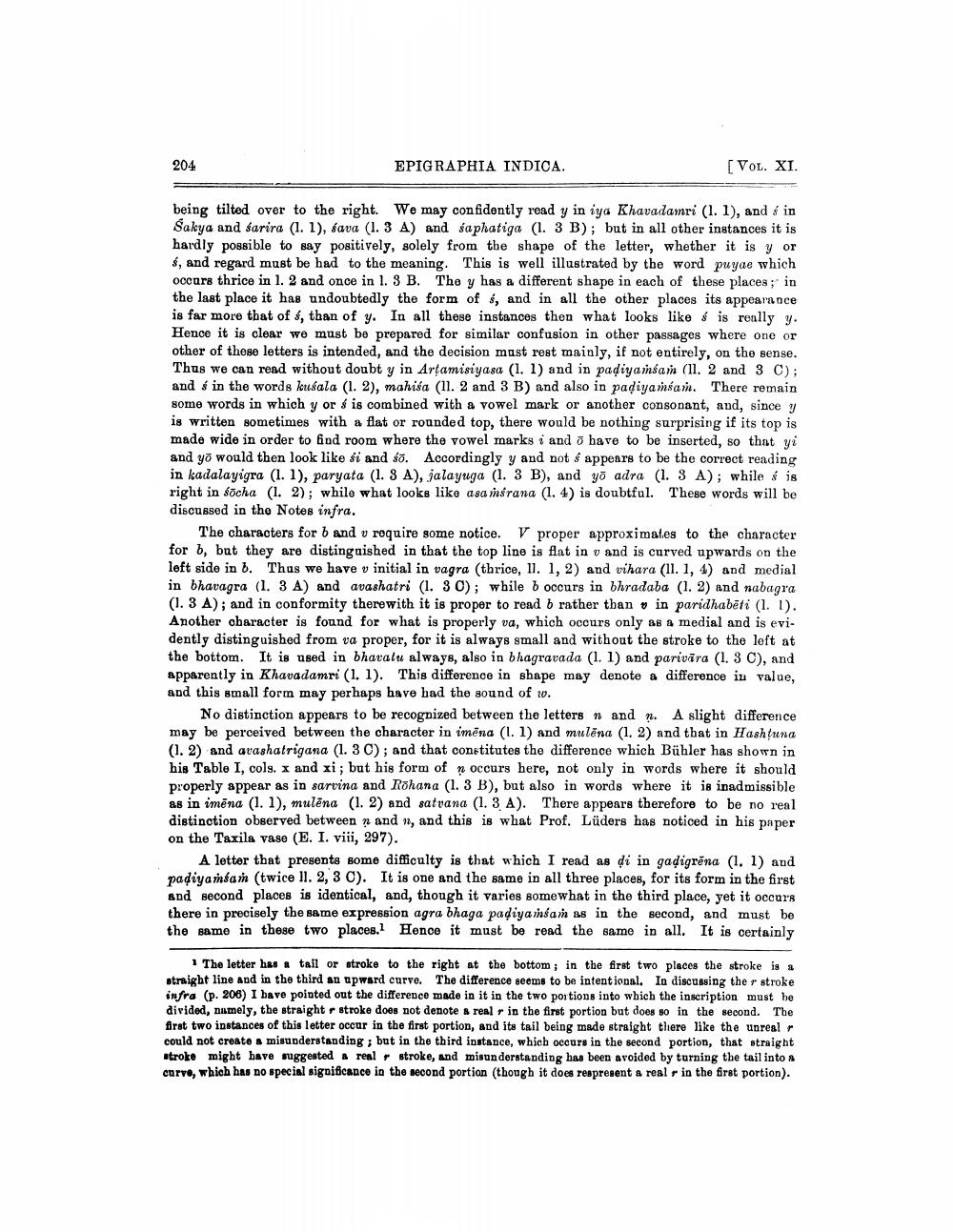________________
204
EPIGRAPHIA INDICA.
[VOL. XI.
being tilted over to the right. We may confidently read y in iya Khavadamri (1.1), and s in Sakya and sarira (1.1), fava (1. 3 A) and saphatiga (1. 3 B); but in all other instances it is hardly possible to say positively, solely from the shape of the letter, whether it is y or f, and regard must be had to the meaning. This is well illustrated by the word puyae which occurs thrice in 1.2 and once in 1. 3 B. The y has a different shape in each of these places; in the last place it has undoubtedly the form of s, and in all the other places its appearance is far more that of $, than of y. In all these instances then what looks like $ is really y. Hence it is clear we must be prepared for similar confusion in other passages where one or other of these letters is intended, and the decision mast rest mainly, if not entirely, on the sense. Thus we can read without doubt y in Artamisiyasa (1.1) and in padiyamsan (ll. 2 and 3 C); and s in the words kusala (1.2), mahisa (11. 2 and 3 B) and also in padiyaman. There remain some words in which y or $ is combined with a vowel mark or another consonant, and, since y is written sometimes with a flat or rounded top, there would be nothing surprising if its top is made wide in order to find room where the vowel marks i and 7 have to be inserted, so that yi and yā would then look like si and fõ. Accordingly y and not $ appears to be the correct reading in kadalayigra (1.1), paryata (1. 3 A), jalayuga (1. 3 B), and yo adra (1. 3 A); while s is right in fõcha (.2); while what looks like asa msrana (1. 4) is doubtful. These words will be discussed in the Notes infra.
The characters for b and v require some notice. V proper approximates to the character for b, but they are distinguished in that the top line is flat in v and is curved upwards on the left side in b. Thus we have v initial in vagra (thrice, 11. 1, 2) and vihara (11. 1, 4) and medial in bhavagra (1. 3 A) and avashatri (1. 3 C); while b occurs in bhradaba (1.2) and nabagra (1. 3 A); and in conformity therewith it is proper to read b rather than o in paridhabēti (1. 1). Another character is found for what is properly va, which occurs only as a medial and is evidently distinguished from va proper, for it is always small and without the stroke to the left at the bottom. It is used in bharalu always, also in bhagravada (1.1) and parivāra (1. 3 C), and apparently in Khavadamri (1. 1). This difference in shape may denote a difference in value, and this small form may perhaps have had the sound of 20.
No distinction appears to be recognized between the letters n and ạ. A slight difference may be perceived between the character in imēna (1.1) and mulēna (1.2) and that in Hashtuna (1.2) and avashatrigana (1. 3 C); and that constitutes the difference which Bühler has shown in his Table I, cols. x and xi; but his form of n occurs here, not only in words where it should properly appear as in sarvina and Rohana (1. 3 B), but also in words where it is inadmissible as in imēna (1.1), mulēna (1.2) and satvana (1. 3 A). There appears therefore to be no real distinction observed between n and », and this is what Prof. Lüders has noticed in his paper on the Taxila vase (E. I. viii, 297).
A letter that presents some difficulty is that which I read as di in gadigrēna (1.1) and padiyarsan (twice 11. 2, 3 C). It is one and the same in all three places, for its form in the first and second places is identical, and, though it varies somewhat in the third place, yet it occurs there in precisely the same expression agra bhaga padiya msam as in the second, and must be the same in these two places. Hence it must be read the same in all. It is certainly
1 The letter has a tail or stroke to the right at the bottom; in the first two places the stroke is straight line and in the third an upward curve. The difference seems to be intentional, In discussing the r stroke infra (p. 206) I bave pointed out the difference made in it in the two portions into which the inscription must be divided, namely, the straight stroke does not denote & real in the first portion but does so in the second. The first two instances of this letter occur in the first portion, and its tail being made straight there like the unreal could not create a misunderstanding ; but in the third instance, which occurs in the second portion, that straight stroke might have suggested real stroke, and misunderstanding has been avoided by turning the tail into a curve, which has no special significance in the second portion (though it does reapresent a real r in the first portion).




